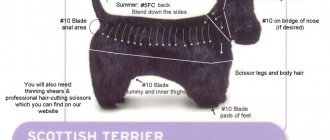Growing conditions
For a fox of absolutely any breed, it is necessary to organize conditions of detention that are as close as possible to its natural environment.
Only in optimal conditions can we talk about good health and development of an exotic animal. Let's look at how to properly keep a fox at home. First you need to find a good veterinarian who will agree to take care of such an unusual pet.
The fox will need timely vaccinations, it is important to keep its health under control - this cannot be done without a specialist.
It is recommended to have your animal's blood tested twice a year. Based on the identified results, the diet of the domestic fox is adjusted.
For such an animal, it is very important to equip a high-quality and comfortable enclosure of optimal height.
It should be made of durable and wear-resistant material that will not fail too quickly. The animal must be locked in the enclosure for the time when the owners leave the home. All foxes are big fans of gnawing and digging, so it is advisable to make a cage out of metal.
In the enclosure, it is advisable to arrange a den that imitates a hole. The animal can hide there.
For the toilet, it is best to choose a dog litter tray. You can fill it with sawdust or a special filler.
All items that break easily and are fragile should be removed away from the fox if it is allowed to move freely around the apartment. We must remember that this pet can jump very high.
The fox can be kept in an outdoor enclosure. But it must have walls, a roof and a floor. In the outdoor enclosure you should place:
- a container filled with sand for digging;
- shelves on which the animal can climb;
- a den where the fox can retire;
- litter tray;
- clean bowls of water and food.
Often foxes in an apartment are moved to live on the balcony. This is a good solution for a simple fox, but the desert fennec will feel comfortable only in conditions where it is dry and warm (about +20 degrees) all year round.
Ideal living conditions for a domestic fox are a separate room or part of it with an equipped partition. Fennec foxes love to bury themselves in the sand and do it surprisingly quickly, so it is better to provide these foxes with the specified bulk material to realize their instinct.
Living at home
The popularity of the fennec cat increased sharply after the release of the cartoon Zootopia, where this cute animal played the main role. Many people have started buying adorable animals as pets.
However, in addition to aesthetic pleasure, fennec will bring its owners a huge number of problems.
The nocturnal lifestyle, the need to maintain a high temperature, and the animal’s habit of digging holes in the sand will become a stumbling block for lovers of domestic exotics.
The fenech will take up an entire room, the floor of which will have to be covered with a thick layer of sand and separate heaters installed. A draft can cause a serious illness for a fennec cat, and there are not many doctors available to help this exotic animal. Therefore, death from a cold comes first when keeping small foxes at home.
Fenech gets along well with other pets, but neither dogs nor cats like such proximity
Particular care must be taken if children live in the house. Still, the fennec is a wild animal and can easily bite or scratch a child, and an adult too.
The smell of a wild animal is very difficult to remove, and it is almost impossible to accustom an animal to a tray.
So let the charming little eared animal live in its natural habitat, where life is not so bad for him.
Wildlife Habitat
The fennec fox lives in places with high air temperatures. For living, the animal chooses thickets of grass or small bushes. It digs holes in the ground in which entire families live, usually up to 10 individuals. The animal is predominantly nocturnal.
Hunts prey alone. It is considered an omnivore because it digs most of its food from the sand. The diet includes insects, fruits and plant rhizomes. Thanks to its excellent hearing, the fennec catches every rustle. No matter where foxes live, they are good hunters.
The lop-eared fox can remain without water for a long time. The animal obtains the moisture necessary for life from food. Knows how to store food. Capable of high jumping up to 70 cm.
Content Features
It is very important to purchase already domesticated baby foxes, since people are often unable to tame an adult animal. Such animals require a lot of attention and care so that they do not pose a threat to humans
It is very important to ensure a comfortable temperature regime for the fox in its place of residence. Due to the cold, foxes of this species may develop eye problems. It is best not to leave the animal at home alone, placing it in an enclosure or a spacious cage specially organized for it. These foxes get along well with other pets, provided they have been raised together since childhood. An extremely difficult question: is it possible to keep such a fox in a house where there are children?
Many experts agree that while children are small, it is best to abandon such an animal. These animals have a very negative attitude towards too loud sounds and very bright light. Since the fox loves to dig holes, it is advisable to keep it in a place where there is sand, otherwise it will dig where it likes, using everything it sees.
If you want to get a long-eared fennec fox, then it is best to take a small fox cub, which is best amenable to education and training. Animals learn to use the litter box in different ways; sometimes a special approach is needed.
Predatory animal instincts will be present in any case, and therefore damage to furniture and household items in the home is possible, so it is recommended to set aside a separate place for keeping the fox; it is also very important to stock up on a lot of toys
Fennec in apartments is a controversial issue; this animal needs a lot of space and its own enclosure for full life. It is preferable to keep such foxes in large houses.
Although these foxes belong to the canine family, they are not treated like dogs, and they are also vaccinated.
It is important to go for a walk with your fennec cat, even if the animal is trained to go to the toilet, in the designated place. But this is only possible in the warm season
Moreover, walking is only possible with a harness, since in an unfamiliar environment the animal may get scared and run away.
What does a fennec fox look like?
Fennec fox (Vulpes zerda) is a desert fox, a cautious and secretive inhabitant. The animal got its name from the Arabic fenek, which means “fox”. However, not all zoologists classify the fennec fox as a genus of foxes, separating it into a special genus - “Fennecus”. At the same time, such significant differences with foxes as a smaller number of chromosomes, the absence of musk glands and sociality are indicated.
The largest population of these amazing animals inhabits the central Sahara. They are also found from northern Morocco to the Sinai and Arabian Peninsulas, and in the south to Chad, Sudan and Niger.
Fenech is the smallest representative of the fox family. The dimensions of an adult individual, including a long (up to 30 cm) fluffy tail, are no more than 70 cm, height at the withers is 18-20 cm. At the same time, the animal weighs only about one and a half kilograms.
But it is not its size, but its ears that amazes the fennec at the first glance. These disproportionately huge ears (up to 15 cm) on a small head, large shiny eyes and a sharp, thin muzzle, lined with long black mustaches, give the whole fox an unusually strange appearance. The ears are so mobile, they take on such diverse shapes that with each new position it seems that you see a new animal in front of you. Without his amazing ears, the fennec would probably lose half of his charm. The ears of a miniature fox, which hear the slightest rustle of a bird or insect at a distance, cannot tolerate sharp sounds.
Since the fennec cat does not have sweat glands and cannot breathe intermittently like a dog, it needs to somehow cool its body. And for this purpose the extensive surface of the ears serves. Since the animal does not sweat, it does not give off a drop of precious moisture. Thus, he manages to be content with the liquid contained in the food. But in places where there are watering holes, he drinks like other animals.
Interesting fact: many desert inhabitants have large ears, for example, the sand cat, long-eared hedgehog or black-tailed hare. Disproportionately large ears protect animals from overheating.
All other parts of the Fennec's body are very beautiful and proportional. The animal's thin legs, like those of all desert animals, will stand up for themselves and compete with the fastest animals in running. Even the Egyptian jerboa, despite all its speed, often falls on the sharp teeth of a small predator. And this applies equally to his ability to sneak up and to the speed of his movements. The vast expanses of the desert, as well as the scarcity of its plant and animal life, require good, tireless legs. And such legs are especially needed for predators! They need not only to run around huge spaces each time, but to be able to catch up with their prey. And the fennec's legs give him the opportunity to exist and reproduce in sandy deserts. The fox's feet are covered with fur, which allows it to move silently across the hot sand. Quite thick at first glance, the body is actually very small and light. It appears this way only because of its long, thick, light sand-colored fur. On a light muzzle, black eyes and a nose stand out.
The fennec's tail, no less fluffy than the tail of our common fox, serves as a good decoration for the entire figure of the animal.
Who is Fennec?
The fennec fox is a small animal, its homeland is considered to be North Africa. Belonging to the canine family, their size is small, they are smaller than domestic cats.
The weight of the fennec cat does not exceed 1.5 kg, the main feature is large ears measuring 15 cm, and the body itself is only 30 cm long. Such a non-standard ear size is necessary to maintain temperature; the large area of the ears and blood vessels cools it in the heat.
Fennec foxes are born with a white color, which later changes to red or fawn. The fur is very long and soft. The animals' inherent jumping ability allows them to jump up to 70 cm in height and a distance of 1 meter.
Forming packs, foxes hunt one at a time. They live in burrows with a complex pattern of passages. One night is enough for the fennec to dig a hole 5 m long.
Foxes do not tolerate cold very well, so during frosty periods they need to be provided with warmth. Because of the cold, the animal often develops problems with its eyes; if it catches a cold, it can die.
The difficulty of taming an animal depends on the age at which it appeared in the house. At first the animal will need a lot of attention; you should not shout at it, as it may get scared.
Appearance, description of Fenech
The Arabs called this miniature animal from the canine family fanak (translated as “fox”). The fennec fox, which is smaller in size than a cat, is classified as a fox, but not all biologists recognize this relationship, recalling the differences between typical foxes and fennec foxes.
Thus, the fennec DNA consists of 32 pairs of chromosomes, while in other species of foxes it consists of 35-39 pairs. Foxes are considered loners, while fennecs live in large families. Taking these features into account, some biologists have assigned the long-eared foxes to a separate genus called Fennecus.
The animal weighs around 1.5 kg with a height of 18-22 cm. The fluffy tail is almost equal in length to the body, reaching 30-40 cm. The ears are so large (15 cm) that, if desired, the fennec could hide his a small pointed muzzle.
Feet covered with fur are also adapted to living in the desert: thanks to it, the fox does not get burned while running on the hot sand. The color of the fur on top (fawn or reddish) allows the fennec to blend in with the sand dunes. The coat is abundant and soft. In young animals, the fur has the shade of baked milk.
The fennec cat's teeth, including fangs, are small. The eyes, vibrissae and nose are colored black. Like other foxes, the fennec fox is devoid of sweat glands, but, like them, it has a supra-tail (violet) gland at the tip of the tail, which is responsible for a pungent odor when frightened.
How to make your home safe for fennec cats?
Make sure that electrical wires and sockets are not accessible to your fennec cat. Floors should always be clean: any small objects that the fox finds on the floor can be swallowed by him.
Do not leave breakable or fragile things where the fox can reach them. Fenech can easily jump even on a fairly high table.
To avoid an accident, do not forget to close the toilet lid.
Even a plastic bag carelessly left on the floor will cause a curious fennec to try to explore and play with it. This will most likely end with the animal getting tangled in the handles.
Lock your windows and front door, otherwise you risk never seeing your pet again.
Many Fennecs love to dig through garbage bags or have a particular predilection for pieces of furniture or carpets. You can give your fennec a gift - give him an old sofa, in which he will definitely dig a hole.
They love to chew on metal things (buttons, coins, etc.). Keep in mind, this is very dangerous for animals, they should not have access to such things. Another passion of theirs is things made from rubber and leather. If an animal swallows such an object, it may need emergency veterinary attention.
Reproduction
Fennec cats reach sexual maturity at approximately 6-9 months, and the first mating occurs at the age of 9 months to a year. Fennec foxes are monogamous, permanent pairs last for several breeding seasons.
The mating season of animals begins in January-February. The female's estrus (estrus) is very short: 1-2 days, the pre-estrus period (proestrus) is mainly expressed in swelling of the vulva (external genitalia) and is also short-lived. The activity of the testes in males is synchronized with the cycle of females: their productivity is maximum when the female is in estrus, then decreases.
Courtship behavior during the mating season among fennec cats has been better studied in captivity, since observations in natural conditions (in the desert at night) are extremely difficult to organize. A typical ritual preceding mating consists of noisy flirtations and usually lasts from one to one and a half days. Mating lasts more than an hour, sometimes several times with an interval of several hours.
Data on crossing vary: some sources say that it occurs quite rarely, others say that it occurs frequently and can take up to 165 minutes. In nature, social mechanisms prevent inbreeding, but in captivity fennecs of both sexes can mate with their own offspring.
Pregnancy in fennec cats usually lasts 50-52 days, although there is evidence from zoos of successful births after 62- and 63-day pregnancies. In the wild, puppies are usually born in March-April. In captivity, mating, pregnancy and birth can occur at any time of the year.
However, even in captivity, most pups are born between March and July. Fennecs give birth to one litter per year, but if it is lost, the female may come into heat and become pregnant again. Thus, fenechs cannot be called truly monoestrous animals.
Before, during and after birth, the male protects the hole, but does not enter the nesting chamber: the female at this time is aggressive and selflessly protects the cubs. A female usually gives birth to two to five blind, fur-covered puppies weighing 40-45 g (however, litters with one or six cubs are less common).
The length of the body and head of a one-day-old puppy is 10-12 cm, the length of the tail is 4 cm, the length of the ear is 1 cm. After 8-11 days, the fennec fox opens its eyes, and its weight doubles after 11-12 days. After two weeks, the baby is already able to move, however, it does not immediately leave the hole.
Florence Perroux/La Palmyre Zoo, France
Until the puppies are 4 weeks old, the male actively defends the area near the burrow and brings prey. At this time, the fennec cubs begin to leave the hole, first for a short time, then for an increasingly longer time. By the middle of the 3rd week, milk feeding is also transferred outside. At this time, the babies are teething, and for the first time they try adult food that the male brings them. After the 4th week, the male brings more and more food to the puppies and female, and meat begins to occupy a significant place in the diet of small fennec cats, although feeding with milk continues until 60-70 days.
The simplest hunting behavior appears approximately 7 weeks after birth, as it is trained it becomes more complex and skillful, but until 13 weeks the male brings prey to the burrow. Only at the age of 3 months do puppies begin to move away from the hole, first together with their parents, and then alone. Fenechs reach sexual and physiological maturity at 9-11 months.
The fennec fox, which is a representative of the canine genus, has recently achieved quite great popularity as a pet. This specimen of the animal world is most suitable for home keeping due to its docile nature. Much to the regret of lovers of exotic pets, such animals can rarely be found on sale, unlike , and if this happens, the price will be very important.
Origin of the species and description
The fennec fox, as a species, belongs to the order of predators, the canine family, and the genus of foxes. The name of the animal comes from fanak, which literally means “fox” in Arabic. First of all, fennecs stand out for their small size and disproportionately large ears. Experts, taking into account such a specific appearance of the animal, often identify a separate genus for it, called Fennecus.
The species name in Latin, Vulpes (and sometimes Fennecus) zerda, literally means “dry fox.” The name arose due to the fact that the fennec tree lives in arid desert areas. The fennec's genetic relative is the bat-eared fox, which shares a common ancestor with it. The fennec fox diverged from common foxes about 4.5 million years ago. Moreover, many common morphological features with foxes and representatives of other “fox-like” species are explained by parallel evolution.
Lifestyle of a miniature fox in nature
In deserts, the fennec tries to stay in thickets of grass and other low-growing vegetation. He lives in holes. The place for them is chosen where the roots of the plants bind the sandy soil. Here the animal digs long passages in various directions. In the middle of these crossing passages, he makes a lair for himself. The animal loves comfort and warmth and therefore lines its lair with dry herbs, hair and even feathers. In such a hole he is safe from his enemies.
The fennec fox, like most other desert inhabitants, prefers the cool to the heat. He spends the whole day in his nest and only in exceptional cases leaves the hole before dusk. During the scorching heat, it’s stuffy even underground. The dhota from the hot sand penetrates there too. The fennec is impatiently waiting for the dazzling shine of the sun, reflected by millions of sparkles in grains of sand, to be replaced by the same sparkles in the dark blue sky of the south. By night the heat is replaced by coolness, and sometimes very significant. Then, here and there in the silent desert, silent animal life awakens. Foxes peep out of their holes, move their ears, sniff the air, and little by little they lean out of the hole: it’s time to hunt.
Before the purchase
When preparing for sale, fox cubs are usually sterilized, but they reproduce well in captivity. Before buying an exotic tiny pet, you need to take into account that it does not smell very nice and makes constant squealing sounds. A sensitive fox may unexpectedly take revenge for an insult, and therefore it is advisable to protect it from small children. But all the comments cannot compare with the pleasure that a playful little charming animal brings. Fenech, like every creature, is responsive to tenderness and love, but only patience and attention will make the fox a full-fledged member of the family.
If you decide to get this cute fox, you can join groups of fennec owners on social networks. There you can read about the peculiarities of fennec care of other owners and chat about your favorites.
How to create a comfortable environment at home
Before getting a fox, you should understand that the fennec is first and foremost a predator. It is possible to grow and tame it at home, but this will require some effort and patience.
In addition, it is necessary to create favorable living conditions for the animal, provide it with a proper, balanced diet and proper care.
Cage and your own corner
The room should be very warm or even hot, otherwise the little fox will start to get sick, and this can result in a big problem, since the animals get sick seriously and for a long time, and it’s not so easy to find a veterinarian who knows how and with what to treat them.
Since the animal loves to dig, it is advisable to organize a play area with sand for it; if this is not done, he will make tunnels in things and furniture, so ensuring the pet’s leisure time is clearly in the interests of the owners.
The safety of the fennec cat plays a big role; his excessive curiosity and activity can play a cruel joke on him. Therefore, always close windows and doors and hide all fragile items. Make sure that the wires are not accessible to your pet fox, as the fennec will definitely be interested in them.
Did you know? A couple from South Africa once rescued a pygmy hippopotamus during a flood, which then became their pet. Hippo Jessica loves her owners very much and does not want to part with them.
Feeding the little animal
In order for the fox cub to feel good, it needs to be provided with a balanced diet. He is not picky about food; You can use dog food, which contains everything your eared animal needs.
If you give preference to natural nutrition, then your diet should include fruits and vegetables, eggs, chicken meat and cereals. A real delicacy for them are lizards, insects and small rodents, as well as dates and figs.
Important! It is best to observe the animal for some time, offering it to taste different foods, and identify its taste preferences, since they can be individual.
Pet care
Breeders have mixed opinions about the difficulty of such training: some say that fox cubs very quickly master going to the litter tray, others say that there are certain problems with this, but in the end everyone overcomes them.
In no case do you forget that the eared cat has the finest hearing; therefore, it is better to avoid loud sounds and conversations in its presence.
Nutrition
Omnivore: the diet contains both meat and plant foods. If there is a lot of meat on his menu, he can become aggressive. It is important to maintain balance.
Feeding principles
In order for the student to be healthy and energetic, vegetables and fruits should be daily food. In the wild, foxes hunt small vertebrates and dig up roots from the soil, which is why it is advisable to please your pet with insects and rodents a couple of times a month. They also give eggs, chicken fillet and cereals, but it is advisable not to get carried away with meat, so as not to cause aggressive behavior. The animals are very fond of carrots, dates, and figs. In some pet stores you can find special fox food, although dog or kitten food is suitable. Meat and vegetable feeds are excellent. Although the fennec cat provides itself with moisture during the day thanks to food, it is important that it has access to fresh water. Proper nutrition typically affects the mood, health and appearance of your pet.
What to feed
• eggs, especially quail eggs; • locusts; • small rodents (mice); • various insects; • small lizards; • cereals with meat; • dry food for kittens; • fruits (dates, figs); • root vegetables; • rarely fermented milk products, grains.
The diet should be balanced, the products are fresh and natural.
Is it possible to walk with a fennec cat?
If you train your fennec cat to take walks, he will be happy to keep you company. However, do not forget that the fennec fox is a heat-loving and gentle animal, for which hypothermia can be deadly. Therefore, in cold autumn, winter and the first half of spring, it is better to refrain from walking with a fennec.
It is better to lead a fennec cat not in a collar, but on a harness. A fennec fox can wriggle out of a collar and run away, and in addition, any accidental, even weak, tug on the leash in this case can cause injury to the cervical spine or larynx.
When walking with a fennec cat, you will have to be vigilant - oncoming dogs may show aggression.
It is better to walk with the fennec early in the morning and late in the evening - this way you will be in unison with the natural biorhythm of the fox.
In the photo: fennec fox
Fennec Fox: walking outside
- If you periodically walk your fox on the street, she will be happy to accompany you. You just have to understand that if an animal gets too cold, it can get sick. Therefore, during cold weather (autumn, winter), leave your Fennec fox at home.
- If you take your pet for a walk in the summer, be sure to take him out on a harness; you should not wear a collar. Fenech will break out of it, and therefore the animal can run far. In addition, you may encounter a situation where a small tug can damage your pet's neck.
Walks
- While walking, carefully monitor the animal. Dogs that walk on the street can cause aggression in Fenech. Therefore, walk the fox early in the morning or late in the evening.
Features of keeping at home
Only this breed of fox can live at home
In order for him to feel comfortable and not get sick, when organizing care for this animal, it is important to consider the following points:
Fenech loves warmth, so the temperature in the room should not be low; when there is no one at home, it is better to put him in a large enclosure; can be kept with other pets; if there are small children in the house, it is better to abandon the fox; it is important to maintain silence; sounds that are too loud can damage the animal’s hearing; Fennecs do not like bright light.
It is preferable to buy a fox when it is still a cub, so it is easier to train. It is quite easy to train a fennec cat to use a sand tray.
The instincts of a wild animal do not disappear, despite living in different conditions. To keep interior items safe from claws and teeth, it is better to stock up on special toys in pet stores.
Living with a fennec cat in a small apartment is quite problematic; it is preferable if it is a country house, it is better to give him a separate room.
Maintenance and breeding
It is impossible to keep a fennec cat in a small apartment. Ideally, the animal will live in a large house and a separate room will be allocated for it.
Breeding is possible. To breed offspring, a male and a female are needed. It’s worth getting used to the fact that fennec foxes constantly squeal. This is how animals communicate with each other and their owner.
Like any pet, a fox needs care and attention. He can make friends with both humans and other pets. Practice confirms that sometimes it is possible to train a fox to sleep at night and be more active during the day. Taking into account the rules of keeping, life with pets will bring only positive emotions to a person.
The fennec fox is a small fox that is one of the 2 species domesticated by humans. Many who kept this animal at home claim that the dwarf fox’s behavior is similar to both a cat and a dog. This animal has an independent character, combined with irrepressible energy and playfulness. In addition, the dwarf fox, like a cat, can jump quite far and high.
Raising a little fox
Although miniature foxes are close to cats in behavior and character, keeping and raising them is much more difficult.
Of great importance is the age at which the fennec tree comes into your home. The earlier this happens, the easier and more successful the process of taming and education will be. Already at 7-9 months the animal reaches sexual maturity. It is up to this age that it is advisable to take a fennec cat into the house. Then the pet will get used to you and your other pets (if you have any) without any problems.
The fennec fox is a desert dweller and, like many other desert inhabitants, is characterized by a nocturnal lifestyle. During the day the animal will sleep, but at night its hunting instincts and natural curiosity will fully manifest themselves. A fennec cat can run around the house, making an unimaginable noise, make various sounds, try to dig tunnels in the floor or sofa, try wires on its teeth, throw things on the floor, etc. In a word, get ready for the fact that night is the time of peak activity for the fennec, and he will restore order in the house. There is only one way out - to give the fennec a spacious enclosure where he can frolic to his heart's content, or even better - a separate specially equipped room in which you need to try to create conditions for the pet that will be as close to natural as possible.
However, the experience of some owners of these animals shows that with due patience and perseverance, the animal can be taught to sleep at night.
It is hardly possible to raise a fox the same way as a dog. But it won’t be difficult to respond to a nickname and teach him to walk on a leash.
Of course, the animal will need a toilet. A cat litter box is usually used as such. The smart little fox quickly understands where to go to do his “business”.
Take care of special toys for your fennec cat that he can chew and sharpen his teeth. Otherwise, the animal will use your shoes or something else for this purpose.
Each fox has its own character and it depends on three factors: heredity, habitat and upbringing. This means what your pet will be like depends largely on you. Do you want your animal to be playful and affectionate? Play with him, treat him kindly, create the necessary conditions for him, take care of him. Fenech is a rather shy animal. The animal will need maximum of your attention, especially at first. When there is a fox cub, you should not make sudden movements, much less shout at him or in his presence. Too loud sounds will not only frighten the fox, but can also damage its hearing.
As already mentioned, fennec foxes usually get along well with other pets, but sometimes cats or dogs can provoke a fox cub into aggression. The same applies to children. If a child hurts a fenech, the animal may bite him. Therefore, it is not recommended for families with small children to have a fennec cat, or at least leave them unattended. Remember that the desert fox is still a wild animal.
How to litter train a Fennec fox?
- A miniature fox, as a rule, lives in a separate room or in a large cage. If you want to train your pet to use a litter box, you will definitely succeed, but some difficulties cannot be ruled out. Sometimes “misses” can happen, especially if the pet is in an excited state.
- There are some animal owners who trained the Fennec fox to wear a diaper. You can use this method if your pet will be constantly in one place.
- Who is better to buy - a girl or a boy Fenech ? What role do spaying and neutering play?
Fennec at home
- If you take a female, then after sterilization her character does not change at all. The same cannot be said about males. They become calm and affectionate.
- Males are by nature more obedient than females. The latter, as a rule, are shy and very nimble. When accustoming a female to the tray, keep in mind that after sterilization, the animal’s urine becomes less pungent in smell.
Fox food
The fauna of foxes is structured in such a way that these predators are able to amazingly adapt and find a convenient moment for this in obtaining food for themselves. Their main food is rodents, birds, fish, and various small animals. In times of hunger they will not refuse carrion, insects and berries.
The interesting thing is that before catching its prey, the fox fully studies its habits. For example, in order to feast on a hedgehog, which she cannot reach because of the thorns, she can sharply push it into a pond.
In the water, the hedgehog turns around and the fox grabs him by the belly with lightning speed. Foxes have to catch wild geese in pairs. One distracts, the other sneaks up and suddenly attacks.
Rodents cannot hide from foxes even under the snow. Incredible hearing detects any rustling noise. The fox is a type of animal that will not be left without food under any difficult weather conditions.
The photo shows a white fox
The fox is a cunning animal. And it is precisely this feature that is its main and distinguishing feature. She helps the animal survive in any critical situation and find a way out of it.
The white fox animal is not a mythical creature. In fact, these animals exist. They are very similar to their relatives with red fur. You can meet them in the tundra, on the Scandinavian Kola Peninsula, in Polar Eurasia and North America, in the south of the Baikal region, in Japan.
How does the Fennec fox play?
- These foxes are quite talkative. They make sounds reminiscent of a dog barking. Fennec foxes also “purr”, sometimes growl, and even snarl. Fennec foxes sometimes make beautiful sounds, similar to birdsong. They do this at night.
- The fox periodically howls pitifully, whines, and grumbles when she wants to play, have fun, and communicate. If you come home and call Fenech to play, the animal will begin to squeal loudly with pleasure.
- At night the fox loves to make noise. Therefore, give her a room located away from the bedroom. There are also quiet individuals. They are able to make calm sounds when greeting their owner in the morning.
You can play
- Many owners let Fenech out of the cage at night so that the animal can walk around the apartment. But it's better not to do this. An unattended fox grabs everything in its mouth, so it can choke.
- Also, the fox often tries to play with its owners and scratch itself with sharp claws.
- But there are Fennec cats that can adapt to the owner’s daily routine. At night they sleep.
If you buy a Fennec fox, you can easily train it to play only during the day. Take care of your pet during the day, in the evening, and play with him. You will notice that by night the animal will run out of energy and the pet will want to sleep. This way, over time, you will teach him to play and lead an active lifestyle only during the day.
- If a fox is constantly alone, it barks. There are also individuals who never do this. They can make sounds that resemble yelps.
- Fenech can yap when excited (while walking outside, when playing with the owner, and so on).
Description and distribution
The body length of an adult short-haired or common wombat (Vombatus ursinus hirsutum) ranges from 80 to 130 cm (average 98 cm), weight from 17 to 40 kg (average 26 kg). Wombats living on the mainland (subspecies Vombatus ursinus hirsutum) grow to larger sizes than those living on the islands.
The common wombat is distributed in the relatively cool and damp parts of southern and eastern Australia, including Tasmania, and in the highlands of southern Queensland. These animals can be found in a variety of habitats, including tropical and eucalyptus forests, alpine meadows and coastal bushland. In some regions they have adapted to human presence and can be seen grazing in fields alongside sheep. These clumsy but very cute animals are covered with thick fur, colored brown, gray or black. Unlike other marsupials, wombats have only one pair of front teeth, and they are constantly growing.
Hedgehog
Hedgehogs are not rodents, and they are not related to porcupines. They are in the subfamily known as Erinaceinae (originally known as insectivores.) Hedgehogs deserve the number one spot on this list for being the easiest to care for, being "exotic" (although the forms you find in pet stores are somewhat different from wild forms, which makes them domesticated.)
- Hedgehogs are not social, so there should only be one in each enclosure. This makes them pets that are not susceptible to separation anxiety and are suitable for people who travel.
- They are suitable for those who do not want long-lived pets as their lifespan is a courtesy of 5-7 years.
- Hedgehogs have a simplified diet that may consist of high quality prepared foods and/or fruits and insects. They are so common that many pet stores sell food for them.
- Hedgehogs can be somewhat temperamental, but they do well with proper handling and habituation.
- Proper “hedge” accommodations should consist only of a properly sized ground enclosure.
Hedgehogs can even be children's pets due to their easy care. Just be prepared for the cleaning involved with their frequent bowel movements.











